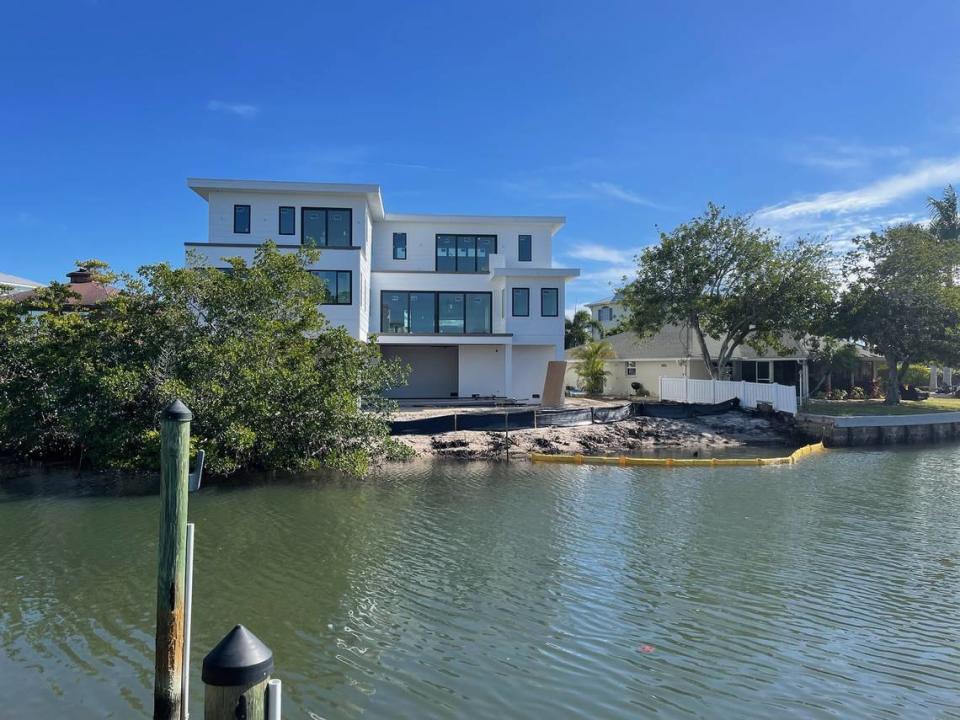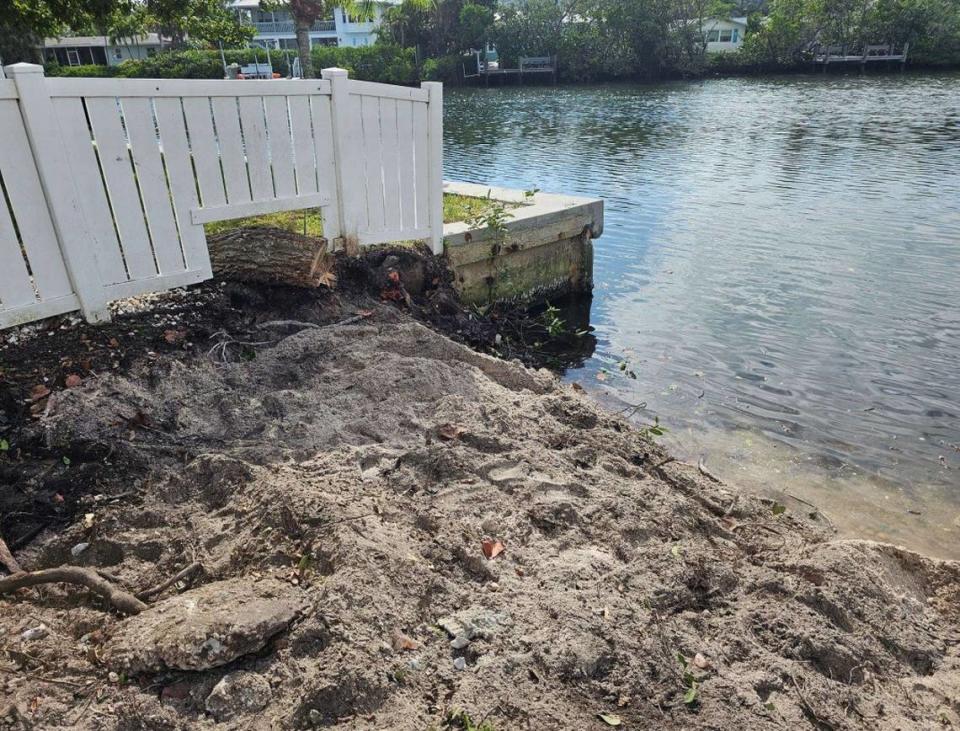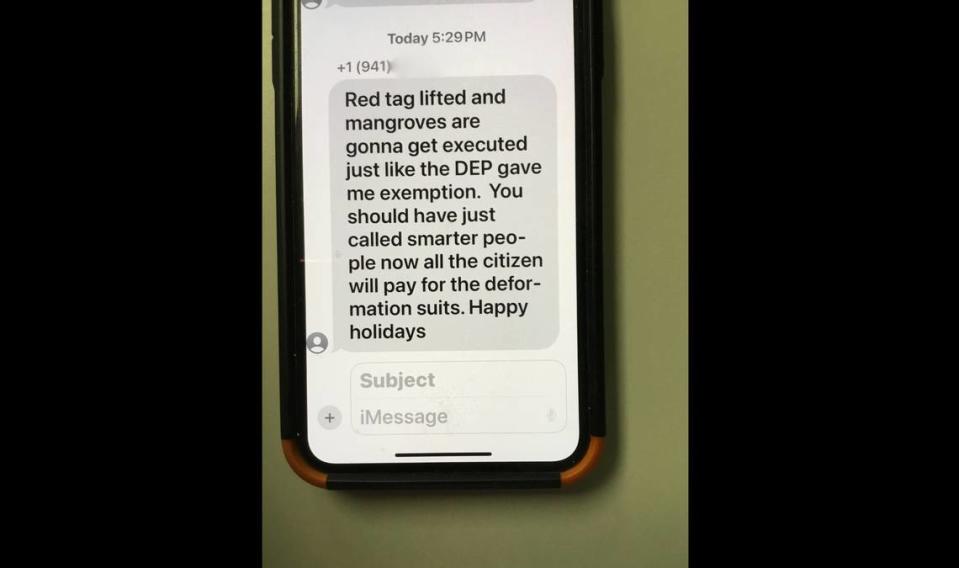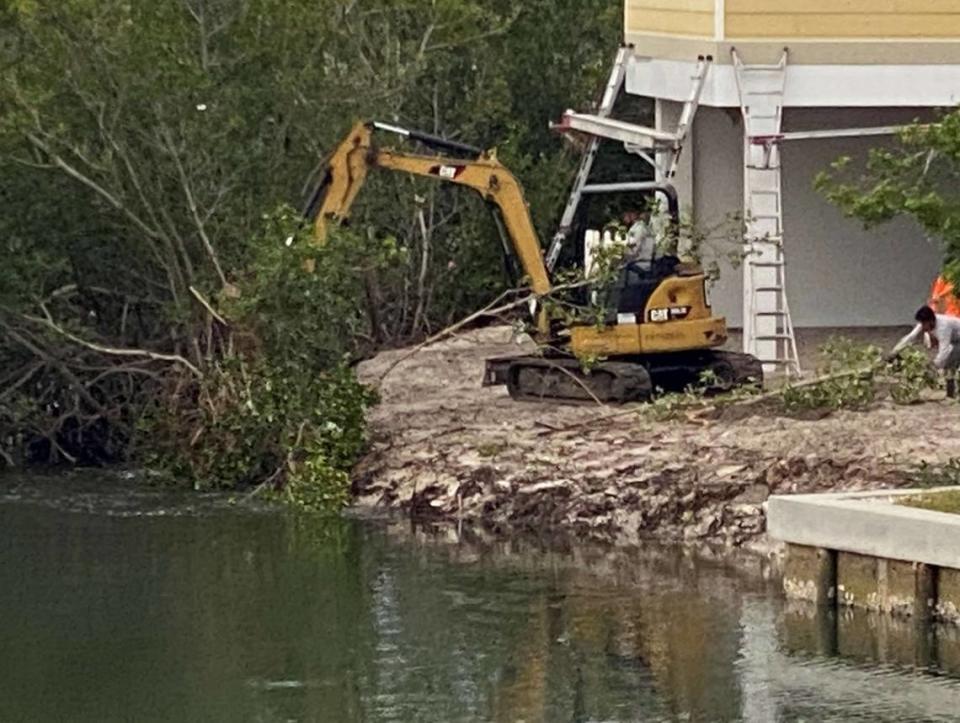Agencies investigating potential ‘unauthorized’ mangrove removal on Anna Maria Island
The removal of mangroves along the shoreline of an Anna Maria Island home is raising concerns among residents and environmental advocates as state officials investigate.
The property owners, a Massachusetts couple that owns a real estate and development company, said they had permission to remove the mangroves and plans to eventually install a seawall.
The site on Gull Drive, where they are building a three-story home, was previously issued a permit by the Florida Department of Environmental Protection (FDEP) that allowed for “limited” removal of mangroves before the seawall installation.
“I get that people might be upset with mangrove removal. But that’s not our issue. FDEP has told me that we had all right to take the mangroves out,” said Jackie Sharp, one of the homeowners.
“We’re just trying to build a house and stay within regulations,” Theo Sharp said.
The project had not yet received permits required to install a seawall by the U.S. Army Corps of Engineers (USACE) or the City of Anna Maria when a contractor started chopping up a large fringe of the protected marine trees in early December, alarming neighbors.
FDEP is now investigating whether the mangrove removal was within the bounds granted by the state.
In an email available in public records, an FDEP official noted that the removal, which was performed by a local contractor, may not have followed best management practices designed to protect the environment.
Protected under Florida law, mangroves provide numerous benefits to the coastal ecosystem and the people who live there. The state’s Fish and Wildlife Research Institute notes they provide habitat and nursery grounds for fish, stabilize the shoreline, protect against storm surge and help maintain water quality by trapping sediment and removing pollutants.
Despite their benefits, the state permits mangrove removal in some instances, such as seawall and dock installations.

Residents report mangrove cutting
The mangrove removal came to the attention of local authorities when Anna Maria residents reported it in early December.
Anna Maria Mayor Dan Murphy said the city received a complaint on Dec. 4 about “extensive removal and alteration of mangroves” at the property. The home is located along a network of water channels from Tampa Bay that reach the interior part of the barrier island.
“As a result of this complaint, City staff visited the property and confirmed that mangroves had been removed and fill dirt had been added in its place,” Murphy wrote. “This scope of work is associated with building permit ACC22-000153 to build a seawall, which has not been issued.”
The city posted a stop-work order on Dec. 6, Murphy said. However, watchful residents soon saw the mangrove removal resume.

Ronnie Leto, who lives across the water from the property, said he was hanging Christmas lights on Dec. 12 when he saw construction equipment rip through the mangroves again, despite the stop-work order.
When he couldn’t find anyone at Anna Maria City Hall, Leto tracked down a sheriff’s deputy. Leto said the deputy went to the property and told the contractor to stop.
The next day, city staff visited the property and found that someone had removed the stop-work order and workers were again taking out mangroves, Murphy said. The stop-work order was later reposted by city officials.
City officials also alerted FDEP of the mangrove removal, including photos.
“It is our understanding that the Army Corps and FDEP agencies are currently investigating and the stop-work order for the seawall remains posted,” Murphy said in an email on Friday.
Leto estimates that a little more than half of the property’s mangroves were removed.
“I am trying everything possible to stop the complete removal of the rest of the mangroves that exist within ... that property line,” Leto said. “We’re losing our natural environment.”
He also opposes the installation of a seawall.
“Nothing is going to grow there,” Leto said.
A project description submitted to USACE said that about 200 square feet of mangrove would be impacted. After reporting the mangrove removal and speaking to a local news outlet, Leto said he received an ominous message from the contractor performing the mangrove removal.

A screenshot of a text provided by Leto reads:
“Red tag lifted and mangroves are gonna get executed just like the DEP gave me exemption.”
The text message came from a phone number that belongs to Frank Agnelli, one of the operators of Bradenton building company Mason Martin, according to a records search.
Agnelli did not respond to a request for comment Tuesday.
Was mangrove removal authorized?
The Florida Department of Environmental Protection regulates mangrove trimming and removal in Florida.
State legislators preempted that authority from local governments, which may apply to take back the role of enforcing mangrove protection rules. For example, Pinellas County and Hillsborough County officials conduct their own mangrove enforcement.
FDEP issued an exemption for the site in September 2022 allowing for the construction of a seawall, approximately 116 feet long and two feet wide, as well as 815 square feet of fill material to level land behind the seawall.
The exemption also allowed for “limited mangrove alteration and removal ... within the footprint of the seawall,” FDEP spokesperson Brian Humphreys said in an email.
But FDEP’s exemption letter notes that permits from other agencies may have been required before construction began. In this case, the installation of a seawall also required permits from the City of Anna Maria and USACE.
“In a large majority of cases, if a property owner is doing something that affects the water of the United States, they will also have to submit to USACE,” USACE spokesperson David Ruderman said.
That permit is still in the application process and has not been approved.

“As you are aware, the Corps is currently reviewing your request for a permit to construct a seawall,” a USACE representative wrote to Jackie Sharp on Dec. 13. “The attached pictures show a potentially unauthorized activity, that is, the removal of mangroves. I will be coordinating with our enforcement manager, but he is currently out of the office for the holidays. Please cease any additional work within waters of the United States, including but not limited to, mangrove removal.”
In response, Sharp said that she had been trying to get in touch with USACE for months regarding the status of the permit application.
“We have tried to be diligent about complying with any requests that you may have, but we cannot do that when you will not communicate with us,” Sharp’s email said. “I am unaware of the unauthorized activity you are referring to but look forward to working with you to resolve any issue that exists in a timely manner.”
FDEP is now investigating the construction activity at the site. Humphreys said an investigation report could be released as soon as this week.
“If it is determined that unauthorized mangrove alteration has occurred, DEP may pursue enforcement against all responsible parties,” Humphreys wrote.
On Dec. 21, USACE was still determining whether it had the resources to visit the site for an inspection.
“We do not have the staff to oversee every single case,” Ruderman said.
An update on USACE’s investigation was not available Wednesday morning.
Property owners respond
The Sharps said the plan to install a seawall was inspired by a neighboring property.
“There are a lot of other seawalls around,” Jackie Sharp said. “It’s an aesthetic thing. It’s upsetting to me that we’re in this situation. We’re getting bullied over this.”
She said that people who are concerned about the impacts of mangrove removal should take it up with government officials and agencies who regulate it.
“We’re in compliance, as far as we can tell,” Theo Sharp said.
However, the couple said they are considering keeping the remaining mangroves intact.
Waterkeepers: Trim mangroves, don’t remove them
Environmental advocates with Suncoast Waterkeeper argue that owners of waterfront homes should consider trimming mangroves rather than removing them.
“Why would you want to take the mangroves out in the first place?” said Suncoast Waterkeeper chairman Rusty Chinnis. “With the proper trimming, you can still get your view, protect the shore from erosion and protect the habitat.”
When left intact, mangrove trees provide benefits to the environment and people.
“Mangroves serve as nurseries for game and sport fish, stabilize coastal shorelines and improve water quality,” FDEP’s guide to trimming mangroves says. “Mangroves have a vital role in healthy ecosystems and the economic wellbeing of coastal communities.”
Leto says the mangroves also provide a snack for manatees passing through the channel.
“The mangroves are the life of this island and the waterways of Florida,” Leto said. “Why is everybody coming here to see this if we’re going to destroy it? My fight is to draw the line right here and stop it from happening all around.”
For those that do plan to trim mangroves, there are best practices that can protect the health of the trees, and professionals who know the best methods. Resources are available on FDEP’s website at FloridaDEP.gov.
In some cases, a permit is required to trim the trees.
Chinnis also encouraged local governments to explore assuming the role of mangrove protection from the state.
“Manatee County could take over this regulation,” Chinnis said. “They’re our mangroves, and they’re disappearing.”
Chinnis said he is working on an education program about the importance of mangroves for local real estate agents, who could then pass the knowledge on to new residents.
Suncoast Waterkeepers also has a program called Eyes on the Suncoast that encourages residents to report signs of pollution and other water quality issues, like unauthorized mangrove removal.

